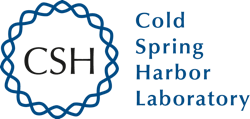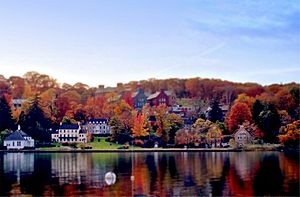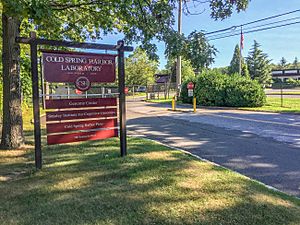Cold Spring Harbor Laboratory facts for kids

The logo of Cold Spring Harbor Laboratory
|
|
| Established | 1890 |
|---|---|
| President | Bruce Stillman |
| Staff | 1,200 |
| Budget | $150 million |
| Location |
1 Bungtown Road
,
,
,
|
|
Cold Spring Harbor Laboratory Historic District
|
|
| Location | Jct. of NY 25A and Bungtown Rd., Laurel Hollow, New York |
| Area | 110 acres (45 ha) |
| Architect | Multiple |
| Architectural style | Multiple |
| NRHP reference No. | 94000198 |
| Added to NRHP | March 30, 1994 |
Cold Spring Harbor Laboratory (CSHL) is a special science center. It is a non-profit place, meaning it doesn't aim to make money. Scientists here study big topics like cancer, how our brains work, plants, and even how to use computers to understand our genes. It is located in Laurel Hollow on Long Island, New York.
CSHL is one of the top cancer research centers in the U.S. It has been a special cancer center since 1987. This lab helped create the fields of modern genetics (the study of genes) and molecular biology (the study of life at a tiny level).
Eight scientists who worked here have won the Nobel Prize. CSHL is known as one of the best places in the world for basic research in these areas. Thomson Reuters ranked it first in the world for molecular biology and genetics. Nature also ranked CSHL first for its research. The lab is currently led by Bruce Stillman, a scientist who studies cells and cancer.
Since it started in 1890, this place has also been a center for learning about biology. CSHL offers programs for scientists, college students, and even teachers and younger students. In the last 10 years, over 81,000 scientists and students have come to CSHL for meetings and courses. Many scientists call CSHL a "crossroads of biological science." Since 2009, CSHL has worked with a group in China to create Cold Spring Harbor Asia. This brings about 3,000 scientists to meetings and courses each year. The Cold Spring Harbor Laboratory School of Biological Sciences was started in 1999.
In 2015, CSHL teamed up with Northwell Health. This partnership helps them do more cancer research. They also work together to test new cancer treatments. This helps train more doctors and scientists in cancer care.
CSHL also hosts bioRxiv. This is a website where scientists can share their research papers before they are officially published.
Contents
What Scientists Study at CSHL
CSHL has 52 labs with over 600 researchers. This includes scientists who have finished their Ph.D. and are doing more training. There are also 125 graduate students and 500 support staff. In total, over 1,200 people work here.
Cell Biology and Genomics Research
Scientists here study how cells work at a very tiny level. They look at things like:
- RNAi and small-RNA (tiny bits of genetic material)
- How DNA copies itself
- How RNA is put together
- How cells send signals
- The structure of our genome (all our DNA)
- Non-coding RNAs (RNAs that don't make proteins)
- New ways to read DNA, like deep sequencing and single-cell sequencing
- How stem cells grow and change
- How chromatin (DNA packaging) works
- The shapes of tiny molecules (structural biology)
- Advanced ways to study proteins (proteomics)
- Using mass spectrometry to identify molecules
- Advanced ways to look at cells (advanced microscopy)
Cancer Research
CSHL scientists study many types of cancer, including:
- Breast cancer
- Prostate cancer
- Blood cancers (like leukemia and lymphoma)
- Myelodysplastic syndrome
- Melanoma (skin cancer)
- Liver, ovarian, cervical, lung, and brain cancers
- Pancreatic cancer
They also focus on:
- Why some cancer treatments stop working (drug resistance)
- The genes involved in cancer (cancer genomics)
- The area around a tumor (tumor microenvironment)
- How cancer cells get energy (cancer metabolism)
- How cells grow in mammals
- How genes are turned on and off
Neuroscience Research
Scientists in neuroscience study the brain and how it works.
- The Stanley Institute studies the genes linked to mental health conditions. These include schizophrenia, bipolar disorder, and depression.
- The Swartz Center studies how a healthy brain thinks. This helps them understand problems in brain disorders.
- Other research areas include:
- The genetics of autism
- Mapping the brains of mammals
- How the brain makes decisions
Plant Biology Research
CSHL has a big focus on plants. They study:
- Sequencing the DNA of plants
- How genes are controlled without changing the DNA itself (epigenetics)
- How plant stem cells work
- How plants interact with their environment
- Using genetics to grow more food, like corn, rice, and wheat
- Increasing fruit yield in plants like tomatoes
They also look at:
- The genetics of water plants for biofuel (energy from plants)
- They help build a big computer system for plant science called iPlant Collaborative.
Much of this work happens at the CSHL Uplands Farm. This 12-acre farm grows crops and other plants for studies. Seven CSHL scientists work mainly on plant biology.
Quantitative Biology Research
The Simons Center for Quantitative Biology uses math and computers to understand biology. They work on:
- Putting together and checking genomes
- Creating math models and computer programs
- Studying how genes change in groups of living things (population genetics)
- Using statistics and machine learning
- Finding information in scientific texts (biomedical text-mining)
- Using cloud computing and Big Data
COVID-19 Research
Scientists at CSHL worked with other groups to study COVID-19. They looked at how the immune system fights infections. They studied special protections called Neutrophil Extracellular Traps (NETs). They collected blood samples and tissue from people with COVID-19.
Learning Programs at CSHL
CSHL does a lot of research, but it also has many learning programs.
School of Biological Sciences
The School of Biological Sciences (SBS) started in 1998. It offers a Ph.D. degree. The school fully pays for each student's research. Students are encouraged to finish their Ph.D. in 4 to 5 years. The Undergraduate Research Program (URP) is for talented college students. The Partners for the Future Program is for advanced high school students. Both are now part of the SBS.
Meetings and Courses
The CSHL Meetings & Courses Program brings over 8,500 scientists each year. They come from all over the world to share their research. Most of this research has not been published yet. They hold about 60 meetings each year. They also offer 30 to 35 courses to teach new technologies. The Cold Spring Harbor Symposium series has been held every year since 1933. It is a place for scientists to discuss genetics, genomics, neuroscience, and plant biology. At the Banbury Center, smaller meetings are held for invited guests. In 2016, a two-week course cost about $3,700 to $4,700 per student. Three-day conferences cost about $1,000 per person.
DNA Learning Center
The DNA Learning Center (DNALC) started in 1988. It was one of the first places to offer hands-on genetics labs. These labs are for middle and high school students. In 2013, 31,000 students learned about genetics at the DNALC. This included students from Long Island and New York City. Over 9,000 high school biology teachers have also taken training programs at the DNALC.
CSHL Press
The Cold Spring Harbor Laboratory Press publishes many things. This includes seven journals, 190 books, lab manuals, and online services. They also publish research papers before they are officially printed.
How CSHL Gets Money
In 2015, CSHL had a budget of $150 million. Over $100 million of this was spent on research. Half of the research money went to cancer studies. Twenty-five percent went to neuroscience. Fifteen percent went to genomics and quantitative biology. Ten percent went to plant sciences.
Here is where the research money came from in 2015:
- 34% from the U.S. government (mainly NIH and NSF)
- 26% from other activities
- 22% from private donations
- 10% from the lab's own funds (endowment)
- 3% from companies
History of CSHL
The institution started in 1890 as The Biological Laboratory. It was a summer program for teachers and students. They studied zoology, botany, and anatomy. This program was started by Eugene G. Blackford and Franklin Hooper. In 1904, the Carnegie Institution for Science started another lab nearby. It was called the Station for Experimental Evolution. In 1921, this station became the Carnegie Institution Department of Genetics.
A Difficult Past: The Eugenics Record Office
Between 1910 and 1939, the lab was home to the Eugenics Record Office (ERO). This office was led by Charles Davenport and Harry H. Laughlin. They were involved in eugenics. Eugenics was a discredited idea that aimed to "improve" the human race through controlled breeding. Davenport was the director of the Carnegie Station until 1934. In 1935, the Carnegie Institution reviewed the ERO's work. They found problems and told the ERO to stop its work. In 1939, all funding for the ERO was stopped, and it closed.
The ERO's ideas and reports were once seen as scientific facts. However, they have since been proven wrong. Their findings were even used to create a law in 1924. This law limited immigrants from southern and eastern Europe. Harry Laughlin had claimed these groups were not as good as immigrants from England and Germany. Today, Cold Spring Harbor Laboratory keeps all the historical records of the ERO. They are used for teaching and research. These documents help people learn about this difficult part of history.
Important Discoveries
Scientists at Cold Spring Harbor made many important discoveries.
- In 1908, George H. Shull discovered hybrid corn. This led to modern agricultural genetics.
- In 1916, Clarence C. Little showed that cancer can be passed down through genes.
- In 1928, E. Carleton MacDowell found a type of mouse that got leukemia naturally. This was an early animal model for cancer.
- In 1933, Oscar Riddle found prolactin, a hormone that helps make milk. Wilbur Swingle helped find adrenocortical hormone, used to treat Addison's disease.
Milislav Demerec became the director in 1941. He changed the lab's focus to the genetics of tiny living things (microbes). This helped scientists study how genes work. During World War Two, Demerec helped increase the production of penicillin.
Starting in 1941, and every year from 1945, important scientists met at Cold Spring Harbor. They were called the Phage Group. Salvador Luria, Max Delbrück, and Alfred Hershey wanted to learn about genes. They studied viruses called bacteriophages that infect bacteria.
- In 1945, Delbrück taught his famous Phage Course for the first time. A young James D. Watson was inspired by it.
- At a CSH Symposium in 1953, Watson first showed the double-helix shape of DNA.
Leadership at CSHL
In 1962, the Department of Genetics joined with the Biological Laboratory. They formed the Cold Spring Harbor Laboratory of Quantitative Biology. In 1970, the name was shortened to Cold Spring Harbor Laboratory.
John Cairns' Leadership
John F. Cairns became the director in 1963. The lab needed money and better buildings. Cairns helped the lab get stable and improved its facilities. He stepped down as director in 1968. While at CSHL, Cairns did important experiments on how DNA copies itself in bacteria.
James Watson's Leadership
James D. Watson was the lab's director and president for 35 years. When he took over in 1968, he focused the lab on cancer research. He created a group to study tumor viruses. He also got government money to expand cancer research. Watson made CSHL financially strong. He also pushed for more research on the brain and mental health issues. This started in the late 1980s. New lab buildings were opened in 1990 and 1999.
In 1994, Watson became president. In 2004, he was named chancellor. He retired in 2007. In 2019, CSHL ended all ties with Watson. They took away his honorary titles. This happened after he made controversial public comments about race. The lab felt these comments went against their values. In 2020, the Watson School of Biological Sciences was renamed to remove his name.
Bruce Stillman's Leadership
Since 1994, Bruce Stillman has led the lab. He is a biochemist and cancer biologist. He became director in 1994 and president in 2003. Stillman is a member of important science groups like the National Academy of Sciences. He still runs a research lab that studies how DNA copies itself. Stillman discovered how the Origin Recognition Complex (ORC) works in 1991. This is a protein that helps DNA start copying.
Stillman has overseen a big expansion of the lab. Its size has tripled since he became director. In 2009, new lab buildings were finished. These added space for cancer and neuroscience research. They also created a new program for quantitative biology. This program brings together experts in math, computer science, and physics to solve biology problems.
Famous Scientists at CSHL
Many famous scientists have worked at CSHL.
- Douglas Fearon: An immunologist who studies the immune system.
- Leemor Joshua-Tor: A structural biologist who studies the shapes of molecules.
- Adrian R. Krainer: Developed a medicine for spinal muscular atrophy (SMA).
- Robert Martienssen: Studies epigenetics, how genes are controlled.
- Bruce Stillman: A molecular biologist and current president of CSHL.
- Bruce Wallace: A geneticist.
- Michael Wigler: Helped discover the Ras oncogene, which is linked to cancer.
- Zachary Lippman: A plant geneticist who won a "Genius grant."
- Christopher Vakoc: A biologist who studies leukemia.
Nobel Prize Winners from CSHL
Eight scientists connected to CSHL have won the Nobel Prize.
- Carol Greider: Discovered how telomeres (ends of chromosomes) relate to cell aging in 1992. She won the Nobel Prize in 2009.
- Barbara McClintock: Discovered transposons ("jumping genes") in 1944. She won the Nobel Prize in 1983.
- Martha Chase and Alfred Hershey: Did experiments in 1952 that showed DNA is the genetic material. Hershey shared the Nobel Prize in 1969.
- Richard J. Roberts and Phillip A. Sharp: Shared a Nobel in 1993. They discovered "split genes" and how RNA splicing works.
- James D. Watson: Shared a Nobel Prize in 1962 for finding the double helix structure of DNA. He was CSHL Director from 1968 to 1993.
Double Helix Medal
Every year, Cold Spring Harbor Laboratory gives out the Double Helix Medal. This award honors people who have helped human health. They might have raised money for research. Or they might have made big discoveries in biology and medicine.
See also
 In Spanish: Laboratorio Cold Spring Harbor para niños
In Spanish: Laboratorio Cold Spring Harbor para niños
- Salk Institute for Biological Studies
- Whitehead Institute
- Massachusetts Institute of Technology
- Harvard University
- Rockefeller University
- California Institute of Technology
- The Scripps Research Institute





